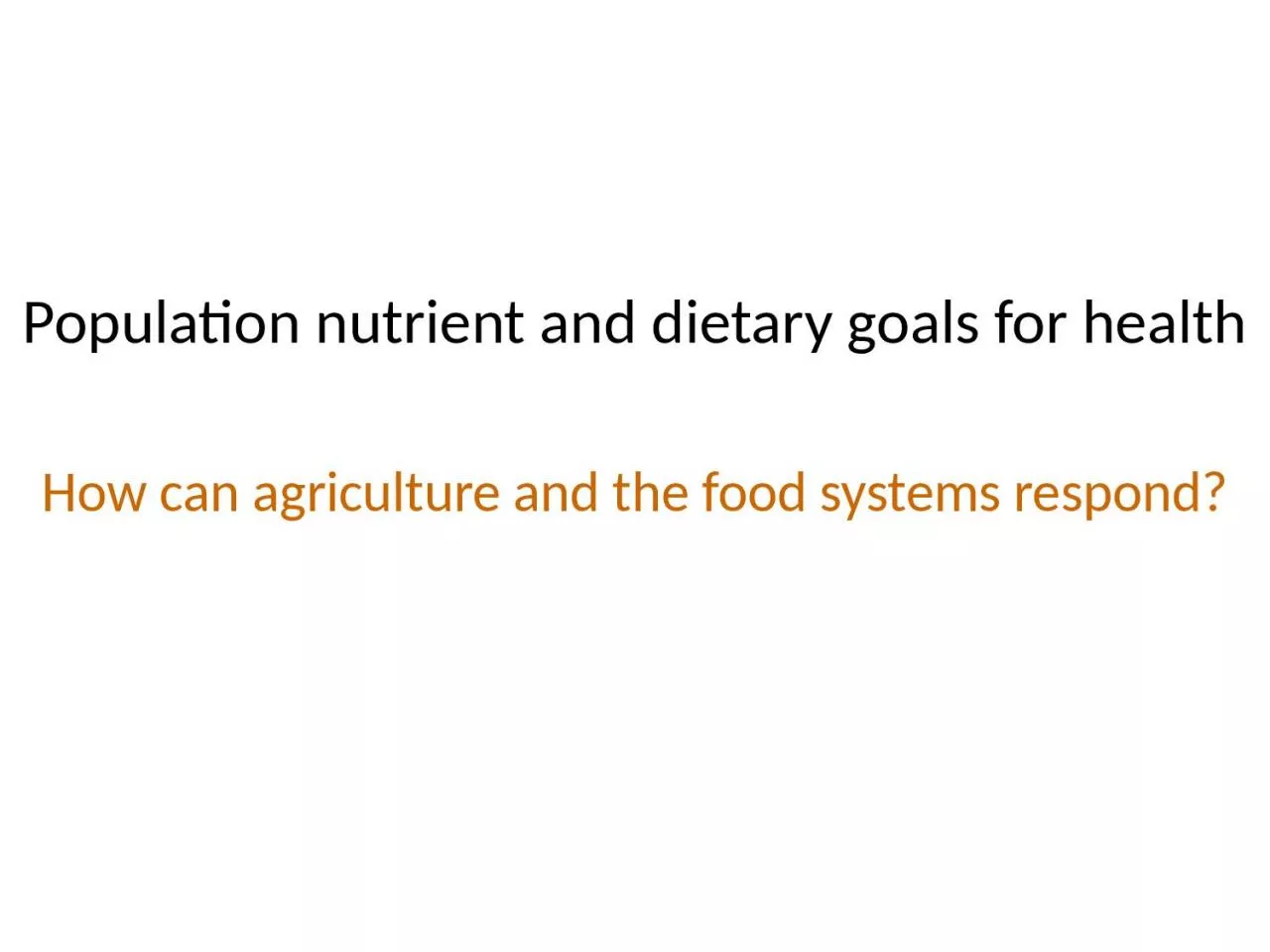

How can agriculture and the food systems respond Recommended Population Nutrient Intake Goals as a share of total energy intake Dietary Factor Recommendations WHOFAO Total Fat 15 30 ID: 1032674
Download Presentation The PPT/PDF document "Population nutrient and dietary goals fo..." is the property of its rightful owner. Permission is granted to download and print the materials on this web site for personal, non-commercial use only, and to display it on your personal computer provided you do not modify the materials and that you retain all copyright notices contained in the materials. By downloading content from our website, you accept the terms of this agreement.
1. Population nutrient and dietary goals for healthHow can agriculture and the food systems respond?
2. Recommended Population Nutrient Intake Goals(as a share of total energy intake)Dietary FactorRecommendations (WHO/FAO)Total Fat15 - 30%Polyunsaturated FA6-10 %Saturated FA<10 %Trans FA<1 %Total Carbohydrate55 – 75 %Free sugars*<10 %Protein10 - 15%* “Free sugars” refers to all monosaccharides and disaccharides added to foods, plus sugars naturally present in honey, syrups and fruit juicesPopulation Nutrient Intake Goals(TRS 916)
3. http://www.fao.org/docrep/005/ac911e/ac911e00.htmRecommended Population Nutrient Intake Goals(in g or mg/person/day)Dietary FactorWHO/FAO RecommendationsCholesterol< 300 mg/daySodium chloride(sodium)<5 g/day(<2 g/day)Fruits and vegetables> 400 g per dayTotal dietary fiber/Non-starch polysaccharides (NSP)(>25 g, or 20g/d of NSP) from whole grain cereals, fruits, and vegetablesPopulation Nutrient Intake Goals(TRS 916)
4. Recommended Dietary Guidelines(WHO, 2004)Dietary recommendations for populations and individuals should include the following:achieve energy balance and a healthy weightlimit energy intake from total fats and shift fat consumption away from saturated fats to unsaturated fats and towards the elimination of trans-fatty acidsincrease consumption of fruits and vegetables, and legumes, whole grains and nutslimit the intake of free sugarslimit salt (sodium) consumption from all sources and ensure that salt is iodized
5. Recommended Dietary GuidelinesConsumption of fish and marine products at least twice a weekRestrict consumption of red meat (processed and unprocessed)These recommendations need to be considered when preparing national policies and dietary guidelines, taking into account the local situation.Improving dietary habits is a societal, not just an individual problem. Therefore it demands a population-based, multi-sectoral, multi-disciplinary, and culturally relevant approach.
6. Priority of objectivesIncrease availabilityImprove quality, diversity, micro-nutrientsImprove access, including within householdsIncrease food safety/utilizationIncrease stability/resilienceImprove sustainability (production/consumption)Address issues of under and over nutrition
7. Figure 4a/b/c/d: Energy and protein availability, 1961, 1981, 1999, 2030Schmidhuber & Shetty, 2005
8. Changes in the structure of diets(1960 – 2030)(World agriculture: towards 2015/2030)
9.
10.
11. Per capita meat consumption increases with incomeBurundiSomaliaUSAJapanIndiaEthiopiaIndonesiaRwandaBoliviaTurkeyAlbaniaUruguaySaudi ArabiaSwedenChina
12.
13.
14.
15.
16. Global and regional trends in supply of vegetables (kg/capita/year)
17. Nutrient Intake trends vs TRS 916 PNI guidelines
18.
19. Monitoring requires information of the distribution: e.g. the 10% sat fat goalfx(x | mean, cv,)PNI goal 10%Mean:15%, cv=0.29
20. Agriculture vs Food SystemsFrom Farm-gate to Plate:WHO Recommendations on Salt (and sodium) intakeWHO deliberations of upper limit for intakes of free sugarFood systems beyond the farm gate have significant impact on intakes of salt and sugars
21. National average ‘apparent’ food consumption trends from FAOSTAT indicate:Increasing energy intakes and free sugar intakesIncreasing contribution from animal foodsIncreasing fat intakes, SFs and PUFAs, sub-optimal fatty acid ratiosImproving F&V availability and consumption Progressive convergence of dietary consumption patterns globally
22. Agriculture and food policies and nutritional guidelines
23. Influencing the role of agriculture in nutrition in this centuryThere is a need to understand the CONTEXTRecognise that IMPACTS of policies that affect agriculture and food systems may be different in different contextsBe aware of the TRADE-OFFS and opportunity costsBe aware of LINKAGES and appreciate the COMPLEXITIES
24. Context 1: A long food chain: Industrial agricultural and industrial food processing in the US
25. Context 2: Short food chain: subsistence production in LDC
26. Concluding commentsFood availability and diversity and hence consumption is increasing.For monitoring purposes, national averages need to be supplemented with distributional information‘Agriculture’ impacts on the continuum from subsistence to highly diversified affluent dietsThe length of the food chain from farm-gate to plate has a much greater impactPolicies and recommendations: Analyse the situation, understand the context, measure impacts within the context, recognize trade-offs, appreciate complexity.